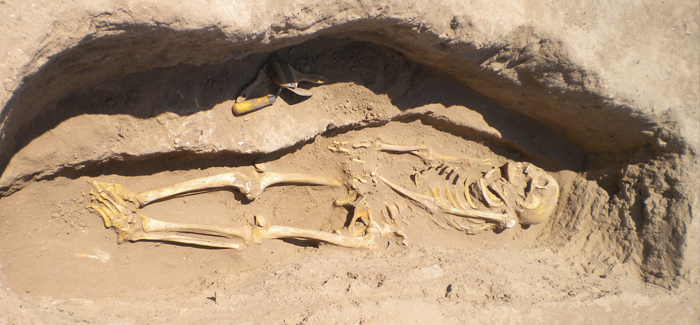
Burial site at the cemetery where the egg was found. (Photo courtesy Gil Stein, Oriental Institute)
A human parasite gets its start in ancient Mesopotamian irrigation ditches, a gaze betrays the difference between love and lust, a prehistoric protein mutation sets the stage for modern biology, and science verifies the old adage that birds do, indeed, fly south for the winter.
When irrigation yielded disease
Uncovering some of the earliest evidence of human civilization’s effect on the environment, researchers found that agricultural irrigation in ancient Mesopotamia may have helped spread disease. Working with researchers from the University of Cambridge and the Cyprus Institute, Oriental Institute director Gil Stein discovered a 6,200-year-old schistosome egg in the pelvis of an ancient Syrian skeleton, the earliest known evidence of the parasite. It can cause anemia, kidney failure, and bladder cancer. Evidence of wheat and barley farms near where the skeleton was found suggests that the parasite thrived in the warm freshwater irrigation systems and infected humans wading in the channels. The research is published in the July Lancet Infectious Diseases.
Love vs lust
Building on previous research showing that love and lust activate different parts of the brain, UChicago psychology research associate Stephanie Cacioppo studied the visual cues differentiating those two emotions. With UChicago psychologist John Cacioppo and Mylene Bolmont from the University of Geneva, she found that eye movements give people away: both men and women gaze at the faces of strangers they see as potential romantic partners and at the bodies of those for whom their desire is more sexual. In each case the judgment is almost instantaneous. “Although little is currently known about the science of love at first sight or how people fall in love,” Stephanie Cacioppo said, these response patterns provide clues into the role that automatic processes such as eye gaze play in differentiating love from lust. The study, published in the July Psychological Science, may help develop diagnostic tools for psychiatrists and couples therapists.
Chances are ...
Evolution is often shaped by rare chance events. Mass extinctions get a lot of press, but a minute protein mutation that took place eons ago was perhaps more profound and fundamental, according to a study by Joe Thornton, UChicago professor of ecology and evolution and human genetics, and University of Oregon scientist Michael J. Harms. Published online June 15 in Nature, the study shows how a mutation in the cellular receptor for the stress hormone cortisol allowed the protein—a key component of the endocrine system—to tolerate later mutations that led to its current function. The findings suggest that “many of our body’s systems work as they do because of very unlikely chance events that happened in our deep evolutionary past,” Thornton said. “If evolutionary history could be relaunched from ancestral starting points, we would almost certainly end up with a radically different biology from the one we have.”
The warmth of southern suns
Biologists have long believed that migration first evolved in tropical birds traveling north in the summer to avoid competition and overcrowding in the warmer tropical regions. But research by biologist Richard Ree, of the Field Museum and the Committee on Evolutionary Biology; PhD student Benjamin Winger; and F. Keith Barker, PhD’99, from the University of Minnesota, contradicts this paradigm. Offering evidence that backs up the common folk wisdom about birds flying south for the winter, their study, which appeared online August 4 in Proceedings of the National Academy of Sciences, reports that most migratory songbirds are from the north, not the south. The researchers studied the lineages of approximately 823 species of North American songbirds and concluded that those with temperate-zone ancestors were twice as likely to develop long-distance migration as those with tropical ones.
